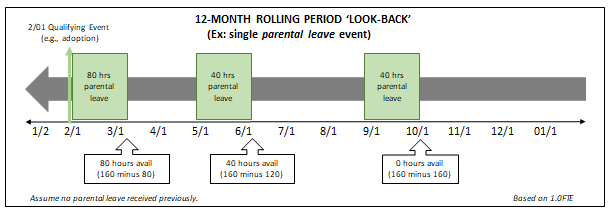1. How does the University define a year?
The year is defined as the 12 months measured backward from the date an employee uses a qualifying leave. With this "rolling" method, each time an employee uses parental leave, the remaining balance of the applicable leave which has not been used during the immediately preceding 12 months is the available leave. An example of how the new calculation method works is below: Example:

2. What happens if an employee has multiple qualifying events within 12 months?
Employees must apply for parental leave with each qualifying event. If the situation is approved as a parental leave qualifying event, the remaining balance of the applicable leave which has not been used during the immediately preceding 12 months is the available leave. Example:

3. If an employee has a break-in-service, does the rolling period start over again to establish the available leave balance?
No. If an employee has a break in service, the parental leave received in the preceding 12 months, including before the break, counts towards the 12-month rolling period.
4. Who can take parental leave and for what purposes?
Eligible University employees, including both the birthing parent and non-birthing parent, may take parental leave for the birth of a child, adoption, and foster placement in the employees’ home.
5. Do multiple births, adoptions, or foster placements at the same time affect the amount of parental leave available?
No. Multiple births, adoptions, or foster placements that occur at the same time (for example, the birth of twins) does not increase the length of eligible parental leave.
6. Can a supervisor deny parental leave?
Supervisors are responsible for ensuring appropriate staffing levels while supporting employees’ requests for time off. Employees are encouraged to work with their supervisor to plan for anticipated time off. If an employee meets the qualifications for Parental Leave Pay, the approved time off will be eligible for pay pursuant to HR-423.
7. May parental leave benefits be used on a reduced work schedule basis?
Yes. Parental leave benefits are available for continuous time off or on a reduced work schedule, one workweek minimum at a time.
8. What does a “reduced work schedule” mean for parental leave purposes?
A reduced work schedule reduces an employee’s usual number of working hours per workweek or per workday, normally from full-time to part-time. Examples of reduced work schedules include:
9. What is the effect of a holiday and/or winter break pay when an employee is on leave?
Employees will receive holiday pay and winter break pay, if eligible, when on a paid leave of absence. In addition, parental Leave hours will not reduce when receiving holiday or winter break hours.
10. What is Annual Base Benefit Rate (ABBR)?
ABBR is the base rate of employees’ earnings (e.g., their hourly rate of pay). It includes income before pre-tax contributions are made to flexible spending accounts or deferred compensation plans. ABBR does not include other income received such as overtime pay, shift differentials, incentive payments, or employer contributions to retirement plans.
11. Is parental leave available for surrogate mothers, sperm donors, miscarriages, or stillbirths?
No. Parental leave is for welcoming a new child into the employee's home (i.e., bonding time) for a newborn child, adoption, or foster placement. Therefore, it is not available for surrogacy, sperm donations, miscarriages, or stillbirths. Please consult with Human Resources to discuss short-term disability for surrogacy or bereavement leave for miscarriages & stillbirths.
12. Is an employee eligible for parental leave even if they are not eligible for FMLA?
Yes. Eligibility for parental leave does not require an employee to be eligible for FMLA. Therefore, while many of the policy elements are the same, an employee may be approved for parental leave even if they are not yet eligible for or have exhausted available leave under, the Family and Medical Leave Act (FMLA) HR-407.
Date Effective: Posted 10-01-2023 with an effective date of 01-01-2024
Date Revised:
Reviewed 2023-10-02